Topic 1 Function and Limits
1.1 Tangent and Velocity
Exercise 1.1 Find the tangent line to the curve defined by at the point using approximations by secant line.
Solution.
The slope of the secant line passing through and another point is given by
When approaches the slope approaches which is the slope of the tangent line.
Using the point-slope formula of the line passing thought with the slope , we can write an equation for the tangent line as follows
Exercise 1.2 If a ball is thrown into the air with a velocity of 50 feet/second, its height in feet seconds later is given by . Estimate the instantaneous velocity when using approximations by average velocity.
Solution.
The average velocity between seconds and seconds after the ball being thrown is given by
When approaches the average velocity approaches the instantaneous velocity which is feet/second.
1.2 Limits of a Function
Note: In this course, the limit of a function is defined/understood independent on how (or whether) is defined at . This is the most popular definition. See the Wiki page Deleted versus non-deleted limits for more detail.
Exercise 1.3 Evaluate the limit using the graph of the function shown in the figure.
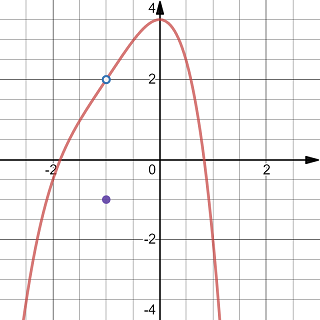
The graph of a function with a point replaced by another point
Solution.
When goes to , the point on the graph goes to the empty dot whose -coordinate is 2. So the limit
Exercise 1.4 Evaluate the limit using the graph of the function shown in the figure.
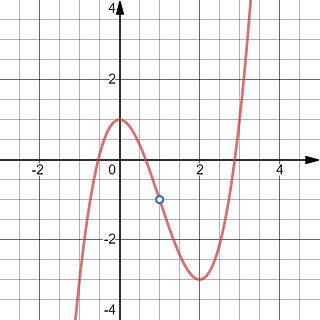
The graph of a function with a point removed
Solution.
When goes to , the point on the graph goes to the empty dot whose -coordinate is -1. So the limit
Exercise 1.5 Use a table of functional values to evaluate
Solution.
To estimate the limit, we evaluate the function at some points that are close to , for example, , , , , , . The function values can be seen in the following table.
| 3-0.01 | -5.99 | 3+0.01 | 6.01 | |
| 3-0.001 | -5.999 | 3+0.001 | 6.001 | |
| 3-0.0001 | -5.9999 | 3+0.0001 | 6.001 |
From the table we see that
So the limit does not exist.
Exercise 1.6 Use a table of functional values to evaluate
Solution.
From the following table,
| -0.01 | 0.00499996 | 0.01 | -0.00499996 | |
| -0.001 | 0.0005 | 0.001 | -0.0005 | |
| -0.0001 | 0.00005 | 0.0001 | -0.00005 |
we estimate that
Exercise 1.7 Consider the piece-wisely defined function
Evaluate the limits and .
Determine if the limit exists. Evaluate the limit if it exists. Otherwise, explain why it does not exist.
Solution.
Using a calculator or a software, we may graph the function. A part of the graph of the function is shown in the following figure (which is created using desmos).
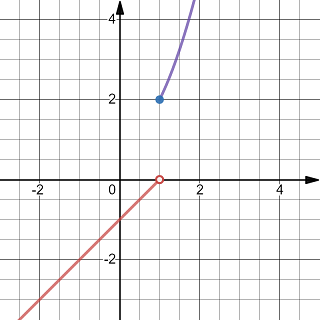
The graph of a piecewise function
From the graph, we see that and .
So the limit does not exist.
Exercise 1.8 Determine if the limit exists. Evaluate the limit if it exists. Otherwise, explain why it does not exist.
Solution.
From the graph of the function show below, we see that the left-limit and the right-limit do not agree. So the limit does not exist.
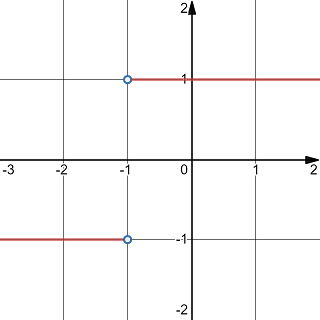
The graph of a function involve absolute value
Exercise 1.9 Determine the limit
Solution.
As goes to , goes to and goes to . The limits go to either infinity or negative infinity.
When , and . So .
When , and . So .
This can also be seen by graphing the function.
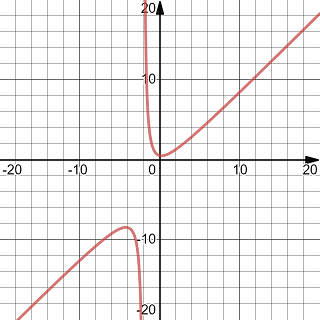
The graph of a function with infinite limits at x=-2
Exercise 1.10 Determine the limit
Solution.
We note that the rational expression can be simplified and the limit equals
Since goes to as goes to from the right, the value of the limit is
1.3 The Limit Laws
Theorem 1.1 (Basic Limit Results) For a constant number , given a real number , we have
Theorem 1.2 (The Limit Laws) Suppose that the limits
exists.
1. Sum:
2. Scalar Multiplication: For any constant ,
3. Product:
4. Quotient: Suppose .
5. Power: For a positive integer ,
6. Radical: For a positive integer , assume if is even,
Theorem 1.3 (Substitution Theorem) Let and be polynomials. Suppose that . Then
Theorem 1.4 (Squeeze Theorem) Suppose that the functions and are defined and holds on an interval . If then Note: The value may be a finite number, , or . The quantity may be a finite number, , or too.
Applying the squeeze theorem with , we get the following corollary.
Corollary 1.1 Suppose that . Then .
An important limit which can be obtained by using the squeeze theorem is the following one.
Exercise 1.11 Evaluate the limit
Solution.
Since , the limit can be evaluated by plugging in . We get
Exercise 1.12 Evaluate the limit
Solution.
Since , the limit can be evaluated by plugging in . We get
Exercise 1.13 Evaluate the limit
Solution.
By plugging in , we get
Applying the power rule, we get
Exercise 1.14 Evaluate the limit
Solution.
We cannot evaluate the limit directly by plugging in . Because the denominator will be . However, you may notice that the plugging-in trick can be applied after rationalizing the numerator. Here is how to do that.
Exercise 1.15 Evaluate the limit
Solution.
Since directly plugging in does not work, we evaluate the limit by first do some algebraic operations (simplifying and rationalizing the numerator).
Exercise 1.16 Evaluate the limit
Solution.
We first simplify and then evaluate by plugging in.
Exercise 1.17 Evaluate the limit
Solution. Because and . We see that Note that and . By the squeeze theorem,
Exercise 1.18 Evaluate the limit
Solution.
Note that and for . Therefore
Because . Then
Exercise 1.19 Evaluate the limit
Solution. s
Since and . By the sum rule,
Exercise 1.20 Suppose . Evaluate the limit
Solution.
Point-wisely, . Then by the squeeze theorem and the given assumption , we can conclude that
By limit laws, we find that
1.4 Continuity
Intuitively, a function is continuous means that there is no holes or jumps when moving on the graph of the function.
Definition 1.1 A function is continuous at if
Note that the equality requires three true statement to hold.
- The function is well-defined at , that is is in the domain of .
- The limit exists as a finite number.
- The limit equals the value of the function.
If is defined near but is not continuous at , we say that is discontinuous at .
The discontinuity is called a jumping discontinuity if the one-side limits exist but have different values.
A discontinuity is called a removable discontinuity if the limit exists.
A discontinuity is called an infinite discontinuity if a one-side limit is the infinity or the negative infinity.
Note that we may also define continuous from the left or the right using one-side limits.
A function is continuous on an interval if it is continuous at every number in the interval, where at an endpoint of the interval, we understand continuity as from the left or the right.).
Derived from limit laws, we have the following theorem for continuity.
Theorem 1.5 Suppose that two function and are continuous at . For a constant number , the sum , the scalar multiplication , the product , and the quotient (given that ) are all continuous at .
As a corollary to the direct substitution theorem, we know that all polynomial and rational functions are continuous over their domain.
Indeed, it can be proved that root functions and trigonometric functions are also continuous at every number in their domains.
One important operation for producing new functions is the composition. For continuous functions, as you may expect, continuity works well with composition.
Theorem 1.6 Let be a function continuous at and be a function continuous at . Then is continuous at .
A slightly more general result is the following.
Theorem 1.7 Let be a function continuous at and be a function such that . Then
Continuous functions have many important (actually fundamental) properties. One of them, which has been used in the test-point method to solve inequalities in some algebra books, is call the intermediate value theorem.
Theorem 1.8 (Intermediate Value Theorem) Let be a function continuous on the interval . If , then there exists a number such that .
Exercise 1.21 Find the domain of the function and use definition of continuity and limit laws to determine whether the function is continuous over its domain.
Solution.
Since , the domain of the function is . By limit laws, for any number , So the function is continuous over .
Exercise 1.22 Find the domain of the function Use definition of continuity and limit laws to determine whether the function is continuous over its domain.
Solution.
The domain of the function is . When , the function is a rational function and hence continuous at any where except . By limit laws, So the function is continuous over .
Exercise 1.23 Find the domain of the function Use definition of continuity and limit laws to determine whether the function is continuous over its domain.
Solution.
The domain of the function is . By properties of continuous functions, the function is continuous except possibly at . When , the left and right limits are It follows that So the function is continuous over .
Exercise 1.24 Find the discontinuity and determine its type for the function
Solution.
Removing the absolute sign, the function can be written as So the function has a discontinuity at . It’s a jumping discontinuity because
Exercise 1.25 Find the discontinuity and determine its type for the function
Solution.
This function is a rational function which is undefined only at $x=-1#. So a possible discontinuity is at . To determine the type, we find the limit first. So the function has a removable discontinuity at .
Exercise 1.26 Evaluate the limit
Solution.
Since products and compositions of continuous functions are continuous, using properties of continuous functions, we have
Exercise 1.27 Evaluate the limit
Solution.
Since products and compositions of continuous functions are continuous, using properties of continuous functions, we have
Exercise 1.28 Find the value of the constant such that the function is continuous over .
Solution.
The function is only possibly discontinuous at . To make the function continuous at , we first need the existence of the limit.
Since
The limit of exists at if and only if . Solve for , we get and .
Hence .
So the function is continuous over if .
Exercise 1.29 Suppose and are continuous functions over such that , and . Find the limit
Solution.
Because , and the function are continuous. The composite functions and are continuous. By arithmetic rules and the definition of continuous functions, we have note that is a continuous function too. Therefore,
Exercise 1.30 Use the Intermediate Value Theorem to show that the equation has a root in the interval (0, 2).
Solution.
Let . As a linear combination of continuous functions, is also continuous. Note that
The IVT theorem tells us that there exists a number such that . So the equation has a solution in .